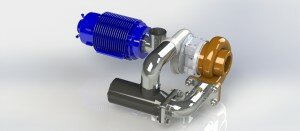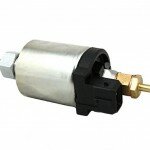Turbine torque
The Movenergy Engine uses intermittent gas power to spin a turbine.
It is a reaction engine, rather than an expansion engine, like the steam engine or IC piston engine. In short pre-compressed air from the compressor is mixed with fuel and fed into the combustion chambers simultaneously, the compressed air/fuel mixture is ignited in the fully sealed combustion chamber and the hot gases of combustion are released through a venturi, turning the turbine in the opposite direction.
The normal drawback in the IC piston engine is the conversion from linear to rotary motion. In order to achieve this conversion a lever is needed. In the IC piston engine this lever is represented by the throw of the crank shaft. This length is governed by the ratio between the bore and the stroke of the engine, and in most cases is less than half this ratio. Thus if you have a 3 inch x 3 inch (bore and stroke) engine the maximum length of the crank throw can be less than half this or less than one and a half inches. Why or how, is this important? For instance, take a lever that is 1 ft long attached at one end to an axle ( imagine a spanner turning a nut) and exert a force of 1 pound at right angles and you generate a torque of 1 ft lb at the axle. Increase the length of the lever to 3 ft and the same 1 pound of force exerted on its end will result in a torque of 3 ft lbs being generated and so on. In simpler terms a lever acts as a force multiplier. In the IC piston engine, because the length of the lever ( crank throw) is so short it acts as a force reducer. Thus if a force of 4000 lbs is exerted on the piston head by the expansion of gases of ignition a 1.45 inch ( lever 0.12 ft) will reduce this force to just: 483 ft lbs of torque, further since the force applied by the connecting rod is not at right angles but at a continuously changing angle as the piston moves down the cylinder and the fact that the exhaust valve opens at 15 to 20 degrees before BDC results in a further reduction by a factor of 0.173. So the initial force on the piston head is reduced to just 83 foot pounds of torque, this is a massive reduction and is one of the reasons that the IC piston engine is such an inefficient machine. By contrast the Movenergy Engine uses a lever that is almost one and a half feet long it also exerts force at right angles, and so is far more efficient than anything that has gone before. . For example in the IC piston engine design a torque of 83 foot pounds as per the example given above requires a force of 4000 pounds to be exerted on the piston head, by contrast the Movenergy Engine would need a force of just 55 pounds to generate the same torque of 83 foot pounds.The fact that the turbine will exert almost the same initial force as the IC piston engine but will develop an exponentially greater amount of power.
This fact is exploited by the turbine. The extra power generated is used to impart kinetic energy to a generator and then this kinetic energy is slowly bled off to generate electricity.
The MovEnergy Engine work with an excess air-to-fuel ratio of 60:1
Internal combustion engine-powered generator sets fueled by natural gas are commanding more attention these days as interest grows in on-site power production equipment that is both efficient and environmentally friendly.
In response to this interest, manufacturers have introduced natural gas engine-powered generator sets that feature “lean-burn” technology. The combustion is considered “lean” when excess air is introduced into the engine along with the fuel.
Lean-burn means pretty much what it says. It is a lean amount of fuel supplied to and burned in an engine’s combustion chamber. Normal air-to-fuel ratio is on the order of 15:1 (15 parts air to 1 part fuel). True lean-burn can go as high as 23:1.
Lean-burn engines (both gasoline and diesel) enjoy higher fuel economy and cleaner emissions than conventionally tuned engines. By nature they use less fuel and emit fewer unburned hydrocarbons and greenhouse gases while producing equivalent power of a like-sized “normal” combustion engine. They achieve lean-burn status by employing higher combustion chamber compression ratios (higher cylinder pressure), significant air intake swirl and precise lean-metered direct fuel injection.
Fuel injector
The fuel injector is responsible for introducing fuel to the combustion zone and, is responsible for mixing the fuel and air. There are four primary types of fuel injectors; pressure-atomizing, air blast, vaporizing, and premix/prevaporizing injectors.
Movenergy does not inject fuel, electronic arrival of the oil drop by drop, start it pulse 600 drops per minute, then the number of kwh generate a module manages it is between 300 and 150 drops per minute.
The rotor of the generator and the turbine shaft to rotate freely and are secured, a 25,000 rpm if we let the generator run without burning it turn out for at least 10 minutes.
MovEnergy uses a standard ECU with sensors turbo speed, temperature of the air , turbo, voltage,fuel which regulates arrived dropwise fuel oil and water to maintain the speed of rototion of generator has + – 25,000 rpm. She has completely reprogram the ECU.


